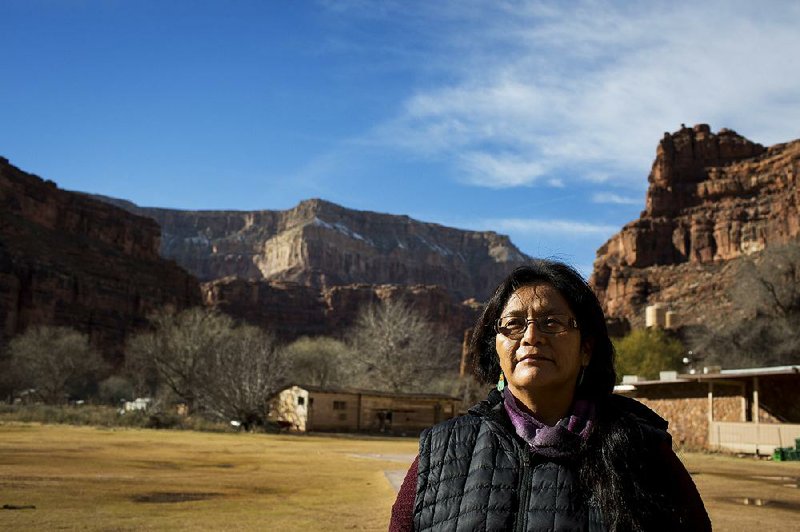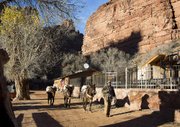SUPAI, Ariz. -- Students at Havasupai Elementary, the only school in this tribal village near Grand Canyon National Park, say they don't have a regular schedule of science and social studies classes, or gym or art classes, either. Often there are not enough teachers, they say.
The children -- in kindergarten through eighth grade -- learn mostly reading and math, though barely. In the most recent evaluation made public, they tested at the first and third percentile, well below every other school on Indian reservations, already among the worst in the country.
The abysmal test scores are highlighted in a federal lawsuit filed this month against the government by the Havasupai Tribe on behalf of nine students at the school. The tribe, a dwindling nation of 730, says the United States has reneged on its legal duty to educate their children by, among other things, allowing a janitor and a secretary to fill in for absent teachers, and by failing to provide special-education services and enough books for all students.
"It's frankly a disgrace that these conditions exist in schools that are run by the federal government and have existed for many years," said Kathryn Eidmann, a lawyer at Public Counsel, a law firm in Los Angeles that joined the Native American Disability Law Center and other groups to represent the students in the lawsuit.
Reached by email, Jeff Williamson, principal of Havasupai Elementary, declined to comment.
Tribal schools like Havasupai Elementary are overseen by the Interior Department, whose secretary under the Obama administration, Sally Jewell, once called them "an embarrassment" because of their dismal conditions and performance.
In an exit memo detailing the state of her agency's portfolio, Jewell deemed the education and welfare of American Indian youths as "perhaps the area that demands the most attention from the next administration and Congress."
Though the legal action deals with conditions at Havasupai Elementary, the problems can be found across the entire system of American Indian schools. The case, the students' lawyers said, is at once a statement of the historic failures that persisted under President Barack Obama and a warning to President Donald Trump that the tribe will not allow its needs to be forgotten.
The position of the Trump administration on these schools is unclear; officials at the Interior Department did not immediately respond to requests for comment.
After visiting the Standing Rock Sioux Reservation in North Dakota while president in 2014, Obama pledged to break the cycle of poverty among indigenous children, in part by giving tribes a leading role in their education, which is something that many tribes have long asked for, as a matter of sovereignty.
His administration spent hundreds of millions of dollars to address decades of poor choices at the department's Bureau of Indian Education, which funds and operates Havasupai Elementary and 182 other tribal schools in 23 states. Some schools have been connected to high-speed Internet or undergone critical repairs, though there is still a lot to be done.
A report by the department's inspector general, released in September, found mold and asbestos in common areas, faulty electrical systems, structural problems and other deficiencies in schools throughout the system.
In its effort to transfer more authority over schools to the tribes, the administration started a program to train indigenous teachers to teach in indigenous schools. Ahniwake Rose, executive director of the National Indian Education Association, an advocacy group, said this was an important first step.
Her hope, she said, is that the idea of choice, so fervently embraced by Betsy DeVos, who has been nominated as secretary of education by Trump, ultimately translates into "giving tribes the choice to run their own schools."
American Indian children have a large gap to bridge. In general, their schools are poor-performing. The high school graduation rate among those enrolled in bureau schools is 53 percent, nearly 30 points below the national average.
Havasupai Elementary was closed for winter break on a recent daylong visit to the village, a place so remote that it is reachable only by helicopter or along 8 steep miles on foot or horseback. The Havasupai Tribal Council, its governing body, was meeting in the dark because the power had been out on the reservation for almost a full day.
"We're not asking for a handout" for the schools, said Carletta Tilousi, a member of the council. "All we're asking is that the government fulfill its obligation and help us help our people."
The Havasupai are known as the people of the blue-green water, a nod to the turquoise falls that cascade from high up nearby mountains and that have turned this place into a tourist destination.
The water courses through the edge of the village along a skinny creek -- a streak of Technicolor against red rocks and dirt. It is an enchantingly deceptive sight, masking needs and wants all around it: boarded-up homes, horses grazing in fields of empty bottles and dried grass.
Outside the Havasupai Head Start, a sign warns: "Head Start will not release any child or children to anyone intoxicated or under the influence." Inside, preschoolers learn the language of their ancestors through colorful pictures arranged side by side on the walls.
Havasupai Elementary sits on the opposite side of the helicopter landing zone, which doubles as the center of the village. The school occupies a single-story brick building between the cafe and lodge where tourists eat and sleep. In interviews, two former students said only clear bags were allowed inside the school to make it harder to smuggle in alcohol.
At Havasupai, "you have eighth-graders reading and writing on a second-, third-grade level," said Sheldon Manakaja, a council member who has a grandson at the school. "Our children, when they come out of this school system, they are way behind." He said students who misbehave are routinely sent home, without a note of explanation or homework to make up for what they missed in class.
Debbie Uqualla, who has three grandchildren at the school, could not name a doctor, engineer or lawyer who had graduated from Havasupai Elementary. But she easily recalled the stories of children who had dropped out. Some of those children were her own.
Of her seven sons and daughters, all of whom attended Havasupai, four did not go to or graduate from high school, she said. One is unemployed. The youngest, who is 17, got pregnant and miscarried.
"For most of our people," Uqualla, 55, said while waiting her turn to fly out of the canyon so she could go grocery shopping, "high school is the last point, if you ever get there."
Among the plaintiffs in the case is a woman, identified in court papers as Laila R., who moved out of the reservation to give her sons a chance at a better education. The younger, who is 14, entered a new school in September, a month into eighth grade.
In an interview near his home, he said it was only after he transferred that he read his first book in full, from The Magic Tree House series, which is suited for second grade.
Later his mother told him that he could share with a reporter whatever else he wanted, saying: "Freedom of speech. It's in the Constitution."
The boy turned to her and asked, "What's Constitution?"
SundayMonday on 01/29/2017

